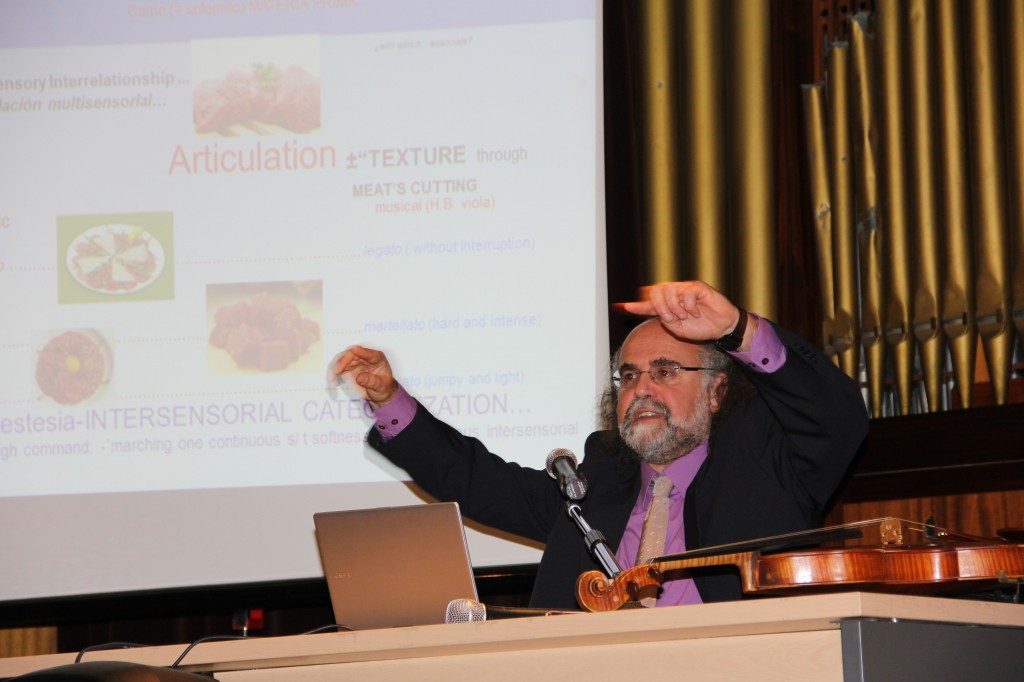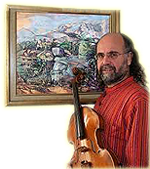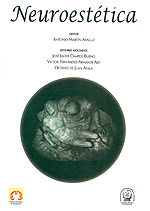Educación musical y cerebro/MUSICAL EDUCATION AND BRAIN
CONFERENCIA PICTOMUSICADELFIA 6.0 14.06.24
ARTÍCULO NEUROBEETHOVEN…EN LA REVISTA ARTSEDUCA (PAPER NEUROBEETHOVEN… IN ARTSEDUCA DIGITAL REVIEW)http://www.e-revistes.uji.es/index.php/artseduca/article/view/2142/1832
12-03-13-semana-del-cerebro-informacion1 http://www.diarioinformacion.com/alicante/2013/03/12/musica-mueve-neuronas/1352498.html
PICTOMUSICADELFÍA: MÚSICA, PINTURA Y CEREBRO. ENSEÑANZA DE UN INSTRUMENTO MUSICAL= SALUD PARA LA MENTE Y EL ESPÍRITU
ABSTRACT
El objetivo primordial de esta conferencia es explicar las leyes elementales de nuestro cerebro para que nuestras enseñanzas y métodos pedagógicos de la música se relacionen con estos mecanismos neuronales constatables con registros de neuroimagen.
Los neurocientíficos y profesores estamos convencidos de que todo ello redundará tanto en el aumento y consolidación de la credibilidad del profesor por parte de discípulos, padres, responsables políticos y, por ende, de toda la sociedad, en estos tiempos de crisis general y de dudas en el estamento funcionarial y educativo.
Parece lógico y obvio pensar que, al final, toda la comunidad educativa saldrá ganando…
Texto completo para CONFERENCIA
PICTOMUSICADELFÍA, Música, pintura y cerebro…
Estudiar música= salud del cuerpo y del espíritu
Tocar un instrumento musical de cuerda frotada como el violín, por ejemplo, es, a nivel cerebral, la actividad que puede realizar el ser humano que más implica, simultáneamente, a las cortezas motora, somatosensorial, auditiva y visual, además del sistema límbico, o sea la estructura emocional del cerebro.
Eso ya lo sabían/intuían los griegos y los mesopotámicos pero sólo ahora se puede demostrar con aparatos electrofisiológicos y de neuroimagen.
Cuando unos padres deciden que su hijo estudie Música (sea el instrumento que sea) están posibilitando mucho más todavía que el espíritu, la belleza y la sensibilidad del legado de un Mozart o de un Beethoven invada plácida e inexorablemente su hogar.
Sí, todavía mucho más…Porque…la música activa tiene más poder que la música pasiva, al igual que la diferencia entre la actividad producida por el brazo normal en comparación con cuando ese brazo es movido pasiva y mecánicamente,…es vehículo excepcional para la formación integral a nivel cultural, humano, disciplinar y pedagógico representado a lo largo de los siglos,…es la mejor herramienta intelectiva, no sólo para optimizar el rendimiento educacional, artístico, de relaciones sociales y de sensibilidad, sino también para el cultivo práctico y diario de conceptos tan necesarios y actuales en nuestra sociedad, tan abocada al materialismo, como son los de solidaridad, democracia, respeto y flexibilidad en el trabajo o en las relaciones personales y emocionales.
Pero no sólo es eso, sino que esa misma tecnología médica ha demostrado, y sigue haciéndolo cada vez más, que el aprendizaje de un instrumento musical es la mejor terapia preventiva y efectiva, si llegase el probable momento de enfrentársele, al, posiblemente, mayor enemigo vital y de nuestra salud que tiene actualmente nuestra sociedad: las enfermedades neurodegenerativas, abanderadas por ese paladín de la infelicidad que es la enfermedad de Alzheimer y otros trastornos similares. Pero la contemplación y el disfrute de obras maestras de un Goya, Van Gogh o Velázquez puede que no le anden a la zaga…
Y por todo ello, creemos que la Pictomusicadelfía, como instrumento de interrelación entre la Música y la Pintura a través del análisis de los medios técnicos y expresivos quizás pueda ayudarnos a abrir una nueva vía personal de pensamiento y de exploración del mundo perceptual y emocional que nos rodea, que nos puede proporcionar, tanto un mayor goce y fruición de los fenómenos estéticos que lo perceptivo y lo emocional conllevan intrínsecamente, como un conocimiento de las bases neuronales y psicológicas de una realidad que nos individualiza como seres humanos y que nos hace, precisamente, humanos, y que puede llevarnos también, quizás, a la apertura de nuevas facetas terapeúticas y clínicas que contribuyan a mejorar nuestra salud física, mental y espiritual.
El objetivo primordial de esta conferencia es establecer y explicar las leyes y procedimientos básicos de nuestro cerebro para que nuestras enseñanzas y métodos pedagógicos de la música se relacionen con estos mecanismos de percepción, procesamiento, memorización, almacenamiento y destilación neuronal, de manera que la metodología y enseñanzas de los profesores, personales o transmitidas través de generaciones de maestros de una misma escuela, no obedezcan a una opinión, a una “doxa” en términos platónicos, o un modo particular de ver un concepto o procedimiento musical, sino a una inevitable e insoslayable ley cerebral de percepción, procesamiento, memorización, anclaje y respuesta neuronal, constatable con registros de electroencefalografía y neuroimagen.
Con ello, nosotros los profesores, daremos carta de legitimación fisiológica a nuestras enseñanzas (al menos, hasta donde la ciencia neurológica actual nos puede permitir) y nuestros alumnos no podrán argumentarnos en contra de que los procedimientos e ideas que les proponemos se basan sólo en la arbitrariedad o punto de vista personal y subjetivo de sus profesores.
Nuestros planteamientos y experimentos cuentan con el soporte científico de la Facultadde Psicología de la Universidad Complutensede Madrid, de la Universidadde las Illes Balears de Palma de Mallorca, del Instituto Cajal de Madrid y en el Proyecto Cajal Blue Brain dela Universidad Polictécnica de Madrid, supervisados por el eminente profesor Niels Birbaumer dela Universidad de Tübingen (Alemania).
El futuro de la inclusión y normalización en la sociedad de las bondades del aprendizaje musical pasa por la difusión por parte de nosotros los neurocientíficos de esa verdad constatable con registros de neuroimagen. Y los músicos tenemos que dejarnos echar una mano por la CIENCIA, para que su credibilidad cale en la sociedad en todos sus niveles. Eso significa Cultura, seguridad, verdad, confianza…y puestos de trabajo para los profesores de música. Y estamos convencidos de que todo ello redundará tanto en el aumento y consolidación de la credibilidad del maestro y el profesor por parte de los discípulos, sus padres, responsables políticos y sociales y, por ende, de toda la sociedad, en estos tiempos de crisis general y de dudas en el estamento funcionarial y educativo, así como en el afianzamiento de la seguridad del profesor en sus propias ideas y métodos de trabajo.
Parece lógico y obvio pensar que, al final, toda la comunidad educativa saldrá ganando…
LECTURE FOR CONSERVATORIES…
PICTOMUSICADELFIA 4.0: MUSIC, PAINTING AND BRAIN. PLAYING A MUSICAL INSTRUMENT = HEALTH FOR BODY AND MIND
ABSTRACT
The primary objective of this lecture is to explain the basic laws of our brain so that our teaching and pedagogical methods of teaching and learning music relate to these neural mechanisms that are verifiable with neuroimaging and electrophysiological recordings.
Neuroscientists and teachers we are convinced that all this will both increase and consolidate the credibility of the teacher by pupils, parents, policy makers and therefore of the whole society, in these times of general crisis and doubts in the civil service and educational establishment.
It seems logical and obvious to think that, ultimately, the entire educational community will win …
FULL TEXT
Playing a musical bowed string instrument like the violin, for example, is in a cerebral level, the activity that involves the most simultaneously activation of the motor, somatosensory, auditory and visual cortices of the human being, in addition to the limbic system, that is, the emotional brain structure.
That was already knew / intuited by the Greeks and Mesopotamians but only now can be demonstrated with electrophysiological and neuroimaging devices.
When parents decide that their childs should study music (whatever the instrument) they are enabling much more still that spirit, beauty and sensitivity of the legacy of a Mozart or a Beethoven were invading placid and inexorably their home.
Yes, still much more … Because … active music has more power than passive music, like the difference between the activity produced by the normal arm compared to when the arm is moved passively and mechanically … is an outstanding vehicle for comprehensive training to cultural, human, disciplinary and pedagogical level represented over the centuries, … is the best intellectual tool, not only to optimize the educational, artistic performance, social relationships and sensitivity, but also for practical and daily nurture of so necessary and current concepts in our society, as doomed to materialism, such as solidarity, democracy, respect and flexibility at work or in personal and emotional relationships.
But not only that, but the same medical technology has proven, and continues proving, that learning a musical instrument is the best preventive and effective therapy, if it would arrived the likely and not wished time to face it, to possibly the highest vital enemy of our health and our society today: neurodegenerative diseases, flagged by that champion of unhappiness which is Alzheimer’s disease and similar disorders. But contemplation and enjoyment of masterpieces by Goya, Velazquez Van Gogh or may not walk behind him …
And all this, we believe that Pictomusicadelfía as an instrument of interaction between music and painting through the analysis of the technical and expressive means may help us to open a new personal way of thinking and exploration of the perceptual and emotional world around us, that might provide us as much greater enjoyment of those aesthetic phenomena that the perceptive and the emotional involve intrinsically, as knowledge of neural and psychological basis of a reality that individualizes us as human beings and makes us, precisely “human”, and it can also lead, perhaps, to the opening of new therapeutic and clinics facets to help improve our physical, mental and spiritual health.
The primary objective of this lecture is to establish and explain the basic laws and procedures of our brain to our teachings and teaching methods of music relate to these mechanisms of perception, processing, memory, storage and neuronal distillation, so that the methodology and teaching of teachers, personal or transmitted through generations of teachers from the same school, not obey an opinion, to a “doxa” in Platonic terms, or a particular way of seeing a concept or musical process, but an inevitable and unavoidable law of cerebral perception, processing, storage, and neuronal anchor, that’s to say a verifiable response electroencephalography and neuroimaging recordings.
With this, we teachers, may give a physiological legitimacy to our teachings (at least as far as the current neurological science can allow us) and our students could not argument against us that the procedures and ideas that we propose are based only on arbitrariness or personal and subjective point of view of their teachers.
Our approaches and experiments have scientific support of the Faculty de Psychology at the Complutense University of Madrid, University of the Illes Balears in Palma de Mallorca, the Cajal Institute in Madrid and the Cajal Blue Brain Project of the Politécnica University of Madrid, supervised by the eminent professor Niels Birbaumer the University of Tubingen (Germany).
The future of inclusion and normalization in the society of the benefits of learning music goes through the spread by we neuroscientists of that truth verifiable by neuroimaging and electroencephalographic recording. And we musicians have to let us lend a hand by science, that its credibility permeate the society at all levels. That means culture, security, truth, trust … and jobs for music teachers. And we are convinced that all this will both increase and consolidate the credibility of the teacher by the pupils, their parents, politicians and social leaders and therefore of the whole society, in these times of general crisis and doubts in the civil service and educational establishment, as well as in strengthening the security of the teacher in his own ideas and working methods.
It seems logical and obvious to think that, ultimately, the entire educational community will win …





